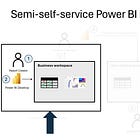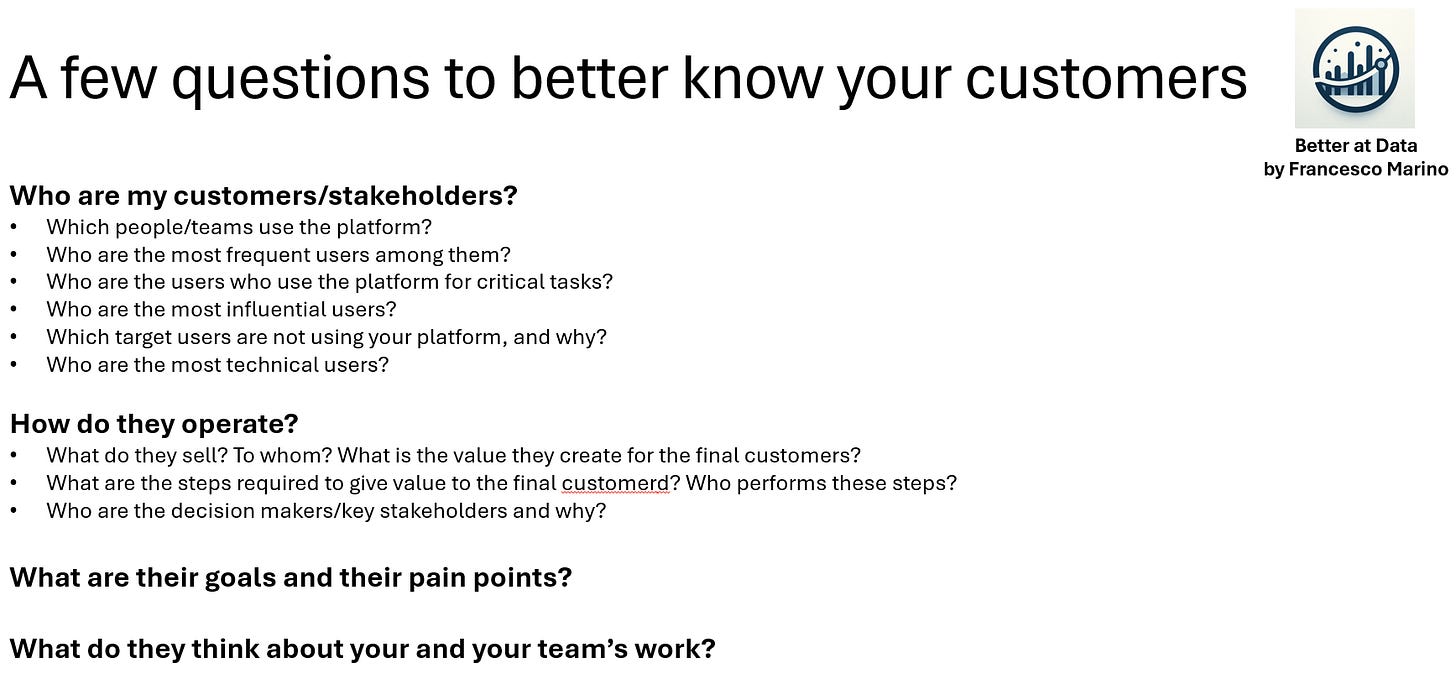7# - 3 ways to improve the relationship with your internal customers/stakeholders (1/2)
and why you should care about it more than you think
Reading time: 9 minutes
Hi there,
Here is Francesco Marino from “Better at Data”. What if improving your relationships with internal stakeholders could not only make your job easier but also multiply your team's impact?
Today we will see a few examples of how you can do that. I wrote this article from the point of view of an IT team manager… but you can apply most of the practices in any role you have.
Before that, did you have a look at the latest article on how to implement a semi-self-service BI model?
Background
Let’s start.
I became a manager almost two years ago and setting up the right relationship with my internal stakeholders and clients made all the difference. From that moment:
My team and the customers’ teams were happier… and this is not to be underestimated: it was just nicer to go to work and feel I was doing something useful.
We had more influence on the book of work. This allowed us to reduce the technical debt and develop more robust solutions. This, in a longer term, increased our impact.
The reputation of the team improved, giving us the opportunity to individually have more impact also on projects outside our area.
From those words, you can already get the first important message:
Give importance to your clients and stakeholders.
Establishing a good relationship is often more important than delivering some more functionalities.
Let me start by giving the definition of customers and stakeholders I use for this article:
Customers: all the users of the products/services that you and your team are responsible for.
Stakeholders: all the people who are investing (not only budgets) in the products/services you are responsible for.
In this article, products and services I am referring to are normally Business Intelligence reports, applications with a user interface or some help in Data Analytics topics, e.g. helping improve data quality or offering trainings.
In any case, you can abstract most of the messages to various other cases. :)
3 ways to improve the relationship with your customers
We can summarize this article with a simple:
Sincerely care about your users.
Sincerely care for their professional objectives, their concerns and their victories.
Sincerely care about them as people and be one of their supporters.
This doesn’t mean doing all that they want. It means working with them, as a team, to help achieve their goals.
But how can you do this in reality? There are different ways to do this.
These are 3 ways that worked for me… But today we will see only one 🙂
1 - Know your customers
The first thing that helped me was knowing my customers, knowing their pain points, their clear objectives, the hidden ones, and what they think.
Here you can find a list of questions that can be useful to know your customers and why I believe these questions are useful.
❓Who are my customers/stakeholders?
These are the questions that can help you understand who the users/stakeholders of your platform are.
Which people/teams use the platform? Map the teams and business areas using your platform, and note how they use it. This list becomes your customer base.
Who are the most frequent users among them?
Who are the users who use the platform for critical tasks?
Who are the most influential users?
You do not have infinite time and sometimes you need to focus on the needs of the most important users. That for me means the users that, with your help, can create the biggest impact in your organization. In most cases, the impact you create is strongly influenced by the usage of your platform, the ability to enable the completion of critical tasks and the reputation of your team coming often from the most influential users.
Let’s stop for one moment here regarding the last point. This doesn’t mean you only have to focus on visibility and success with the most influential users. Real impact should be a priority.
But let’s be pragmatic. To have a bigger impact you need to have more influence. To get more influence you need to have a better reputation with at least some specific people. To reach this point you need then to improve your reputation with the most influential users of your platform.
Which target users are not using your platform, and why?
Often, when you manage an application, you have a target audience. But NOT the whole audience uses your application. It is important to understand who is not using it and why. Maybe they just do not need it now, maybe they need it but they do not know how to use it.
Knowing them can help you plan your work in a way to consider their possible needs, now or in the future.
Who are the most technical users?
When there is a good collaboration with the most technical users of the platform, they can become your best allies to increase your impact.
They understand your challenges, but they also understand the other users’ needs and they work with them daily. They can give you suggestions on how to enable other users or tips on which changes on the platform can be beneficial. And of course, they can be the first adopters of the new functionalities or the testers when there is a platform migration for example. Once you know them, collaborate with them.
🗄How do they operate?
Once you know who your customers are, you need to know how they operate the business. This means understanding:
The business details: what do they sell? To whom? What is the value they create for the final customers?
What are the steps required to create value for the final customer? Who performs these steps?
Who are the decision makers/key stakeholders and why?
These questions will support you in helping your users by anticipating needs, proposing specific technical solutions, involving the right people in the right meetings, by understanding the business decisions that can impact you and your team.
🎯What are their goals and their pain points?
What did we say at the beginning of the article?… Care about your user.
One way of professionally caring about them is helping them achieve their goals and trying to reduce their pain points. Getting information about major business goals and pain points seems easy, but it is not for various reasons.
The easiest way for me to get this information was:
asking about what they do in their daily job, why, and what they are trying to achieve.
mapping what they do with the tools they use and the colleagues they work with.
trying to understand possible pain points in the process and/or asking directly for them.
I followed this approach for each business process for which my reports, data pipelines or new tables were used. This helped me, step by step, to connect the dots and being able to propose meaningful solutions.
Sometimes the solution was as easy as granting access to a report to someone. Sometimes the solution was as complex as collaborating with other 3 technical and business teams to deliver an end-to-end data solution. Sometimes, it was just not possible to do anything.
But in any of those scenarios, I was aware. I was able to understand and then to plan the technical roadmap in the best way to have a positive impact on the users.
In the end, we should just remember that
We can only solve the problems we are aware of.
Becoming aware of the problems is also part of our job 🙂
💬What do they think about your and your team’s work?
The last step in this list to know your customers/stakeholders is to understand what they think about you, about your team and about your platform.
Perception is often reality. If you are doing a great job but your customers see it differently you need to understand why. It is not their fault.
Maybe you are not communicating enough, or you are communicating the wrong message or you are doing great on something they do not care about, and you need to focus on what is more important for them too.
Maybe they think you are doing a good job because you are doing one thing very well. Then you need to know what it is.
Of course, we need to have our own opinion about our work but this should be built also based on the feedback of the people we work with.
Let me share one example: one of my stakeholders told me once that my team was slow considering the amount of work we had to do… But he didn’t see a lot of admin and support work that we were doing behind the scenes.
He did not see it just because no one was telling him about it. From that moment on, we started communicating also the ‘hidden’ and most boring tasks. This, in the end, made the real amount of work clear and the relationship a bit easier.
From this example, we can say that communication with your client/stakeholders is critical. Keeping a constant and open communication is the second way to strengthen relationships, which we’ll explore in the next newsletter.
Summary
The first step to strengthen the relationship with your customers is to know them. Knowing who they are also as humans, how they work, their goals, their challenges, and their perception of you and your team.
Sincerely care, this will always help you.
In the next newsletter we will see other 2 steps:
Constant and open communication
Being simply professional
What strategies have worked for you in building stakeholder relationships? Feel free to reply to this email and share your thoughts!
That’s almost all for today!
Almost because, from this newsletter, I am adding useful articles I have read. Feel free to suggest me something for the next newsletter 🙂
Resources I found useful
Articles:
A good book:
I am currently reading it and for me it is a great resource to became a more advanced Power Query (M) user.
Knowing Power Query is a key skill for professionals in the Analytics sector, also keeping in mind all the many different tools Power Query is currently integrated in.
The Definitive Guide to Power Query M
Do you want to give a feedback about Better at Data? 📝Do it here





